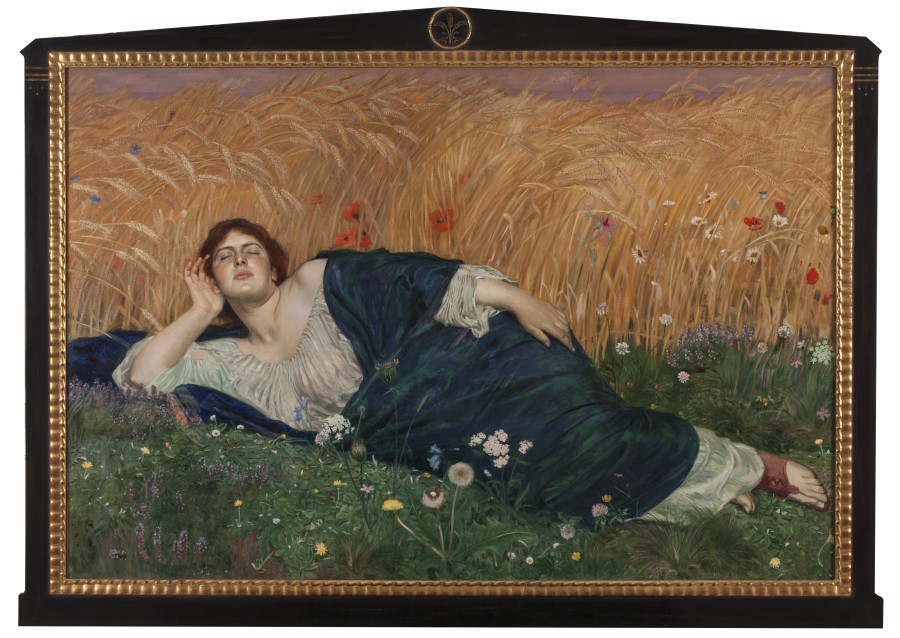Provenance
In the artist’s estate and thence by descent in his family.
Literature
Osmar Schindler in der Dresdener Galerie, Staatliche
Kunstsammlungen, Galerie Neue Meister, Dresden, 2011, pp. 7 and 26.
Frank Fiedler and Uwe Fiedler, Lebensbilder aus der Oberlausitz:
60 Biografien aus Bautzen, Bischofswerda und Umgebung, Nordenstedt,
2014, p. 220.
Growing up near Dresden, Schindler (figs. 1a-b) received his traditional training at the
Dresden Art Academy. In the 1890s he travelled around Europe and seems to have been
particularly interested in Italy and the ancient art he found there (figs. 2a-b), and he would return
often. In the late 1890s he began receiving prizes and commissions for his work. His paintings
from this period already display an interest in classical forms, allegory, and the nude (figs. 3a-c).
In 1900 Schindler was appointed a professor at the Dresden Academy, and there he remained for
the rest of his life, teaching many students, including George Grosz, and producing a wide variety
of works - religious, mythological, portraits, and genre subjects. Already in 1897 he had designed
the poster for Dresden’s International Kunst Ausstellung (fig. 4). Then in the one of 1901 he
exhibited his painting Im Kumtlampenschein (Changing the Horse Collar by Lamp Light) (fig. 5)
for which he received a gold medal. In the 1904 exhibition he showed a mythological, painting,
Hercules (fig. 6) and won a bronze medal. That same year his David and Goliath (fig. 7) was
included in the Saint Louis World’s Fair Exposition.
At the Dresden Academy Schindler taught the class on life modeling, and he perfected a technique
of careful draughtsmanship and, as demonstrated in this remarkable dossier of works, detailed
preparatory studies for his large-scale oils. The subject of this painting is the ancient goddess
Ceres (or Demeter), the goddess of fertility, grain, and agriculture. The central myth concerning
Ceres, the daughter of Saturn, was that her own daughter, Proserpine (Persephone), while picking
flowers in a meadow, was abducted by Pluto, the god of the underworld and taken to his gloomy
realm. Ceres searched frantically for her and forgot her role of making the earth fertile, so that it
remained barren, and people began to suffer. Jupiter, the king of the gods, implored his brother,
Pluto, to release his abducted wife, which he did, but only after she had eaten six pomegranates
seeds grown in the underworld. As a result of this, Proserpine is allowed to spend six months of
the year with her mother and the remaining six with Pluto. Thus, when Proserpine is away, Ceres
sulks, and we have autumn and winter, and when her daughter returns Ceres bestows on us spring
and summer.
As a major goddess, Ceres was often represented in ancient Roman sculptures (figs. 8a-c) that
Schindler would have seen in Italy and that had also inspired a famous composition by Rubens
(fig. 9). She had been depicted often by a variety of later artists (figs. 10a-d), who sometimes
presented the goddess reclining on the ground. In the great old master collection of the Dresden
Museum, Schindler could have seen significant nude figures of Ceres by the painters Cornelis
Cornelisz. and Andrea Celesti (figs. 11a-b). However, the idea for making his draped Ceres a
reclining figure may also have come from the famous pediment frieze of the Parthenon (fig. 12).
In his interpretation Schindler depicts Ceres in a pose with her head on hand, cupping her ear, with
her eyes closed (fig. 13), as if she is listening for the voice of her abducted daughter, Proserpine,
coming from within the earth.
To prepare for his composition Schindler studied his model from life, both nude and clothed, in
drawings and pastels (figs. 14a-c). The preliminary studies provide a remarkable insight into the
methods of an academic artist, as Schindler struggled to achieve the final form of his painting. In
some studies he shows the figure from the back and in others he reverses her position and her
hands (figs. 15a-d). In her role as the goddess of summer, Ceres is usually symbolized by wheat,
and Schindler elaborates on the theme to suggest the changing of the seasons, moving from the
floral fields of spring in the foreground to the field of fully grown waving wheat interlaced with
poppies (a traditional symbol of Ceres) behind her to represent summer. Several of the preparatory
oil sketches are devoted just to the wheat fields (fig. 16). The foreground section of the painting is
filled with an abundance of flowers to suggest the richness of the fertility drawn from the goddess.
These are in fact all wild flowers - dandelions, clover, lobelia, queen anne’s lace, marguerites
(daisies), bluebells, and jacob’s ladder - so one could also read the composition as passing from
untamed nature to the cultivated world of humans. Although the painting of the flowers may look
almost impressionistic in their spontaneity, the artist actually labored quite carefully on producing
realistic blooms, making detailed studies in both graphite and oil, sometimes with inscriptions of
the Latin names of the plants (fig. 17). From the start Schindler also seems to have been thinking
about the frame he intended for the painting and among the drawings are some of the wheat motif
that crowns the frame (fig. 18).
This oil painting and its many related studies present a curious paradox, for it is a very grand
work, but it is not signed and there seems to be no record of the artist having exhibited it in
Dresden. He did, however, produce a lithograph of the subject inscribed with the Greek name of
the goddess, Demeter (fig. 19). This black and white print reverses the composition and adds a
fuller array of flowers. After Schindler’s death in 1927, the oil painting and all the studies
remained with his family, and these works have only emerged in very recent times as a near
miraculous time capsule detailing the artist’s creative process
Osmar Schindler V2 from Horse's Mouth Media on Vimeo.
